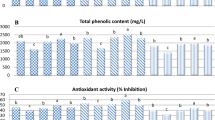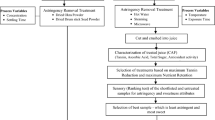Abstract
Coconut inflorescence sap, traditionally called as neera, is a natural and healthy drink obtained by tapping the unopened immature spadix of coconut. The sap tapped by using the device coco-sap chiller, developed by ICAR-Central Plantation Crops Research Institute, is called Kalparasa®. The shelf life of the sap after extraction is 2–3 h in atmospheric condition. Farmer producer companies and palm sap processing industries require suitable preservation techniques to maintain the physico-chemical properties of the coconut sap. Hence, the effect of microwave power level (600 and 900 W) and exposure time (30, 60, 90, and 120 s) on the physico-chemical properties of Kalparasa stored under refrigerated conditions was investigated. The physico-chemical properties of microwave-treated Kalparasa including pH, TSS, titratable acidity, ascorbic acid, total sugar, reducing sugar, and polyphenols were analysed at 1, 3, 5, 7, 9, 12, and 16 days after storage. The results reveal that the microwave treatment and storage period had a significant effect (P < 0.001) on the physico-chemical properties of Kalparasa. Furthermore, it was deduced that a combination of high power (900 W) and exposure time (120 s) maintains the physico-chemical quality of Kalparasa up to 16 days of storage under refrigerated conditions.

Similar content being viewed by others
References
Atputharajah, J.D., S. Widanapathirana, and U. Samarajeewa. 1986. Microbiology and biochemistry of natural fermentation of coconut palm sap. Food Microbiology 3: 273–280.
Borse, B.B., L.J.M. Rao, K. Ramalakshmi, and B. Raghavan. 2007. Chemical composition of volatiles from coconut sap (neera) and effect of processing. Food Chemistry 101(3): 877–880.
Bray, H.G., and W.V. Thorpe. 1954. Analysis of phenolic compounds of interest in metabolism. Methods in Biochemical Analytical 1: 27–52.
Bremus, C., U. Herrmann, S. Bringer-Meyer, and H. Sahm. 2006. The use of microorganisms in L ascorbic acid production. Journal of Biotechnology 124(1): 196–205.
Dubois, M., K.A. Gilles, J.K. Hamilton, P.A. Rebers, and F. Smith. 1956. Colorimetric method for determination of sugars and related substances. Journal of Analytical Chemistry 28: 350–356.
Gupta, R.C., V.K. Jain, and G. Shanker. 1980. Palm sap as a potential starting material for vinegar production. Research and Industry 25: 5–7.
Hebbar, K.B., M. Arivalagan, M.R. Manikantan, A.C. Mathew, C. Thamban, V.T. George, and P. Chowdappa. 2015. Coconut inflorescence sap and its value addition as sugar—Collection techniques, yield, properties and market perspective. Current Science 109(8): 1411–1417.
Hebbar, K.B., R. Pandiselvam, M.R. Manikantan, M. Arivalagan, P. Shameena Beegum, and Chowdappa. 2018. Palm sap—Quality profiles, fermentation chemistry, and preservation methods. Sugar Tech 20(6):621–634. https://doi.org/10.1007/s12355-018-0597-z.
Ho, C.W., W.M. Wan Aida, M.Y. Maskat, and H. Osman. 2007. Changes in volatile compounds of palm sap (Arenga pinnata) during the heating process for production of palm sugar. Food Chemistry 102: 1156–1162.
Iwuoha, C.I., and O.S. Eke. 1996. Nigerian indigenous foods: Their food traditional operation-inherent problems, improvements and current status. Food Research International 29: 527–540.
Juan, A., J.E. Canumir, J.B. Celis, and V.V. Leslie. 2001. Pasteurisation of apple juice by using microwaves. Journal of Food Science 35: 389–392.
Judoamidjojo, R.M., E.G. Said, and L. Hartono. 1989. Bioconversion. Bogor: Bogor Agricultural Institute 4(2): 78–88.
Kapilan, R., R. Kailayalingam, S. Mahilrajan, and S. Srivijeindran. 2015. Determination of efficient fermentation inhibitor of sweet sap of Cocos Nucifera and optimization of concentration for quality outputs in northern Sri Lanka. International Journal of Scientific Research in Agricultural Sciences 2(7): 166–174.
Kumar, S., M. Khadka, R. Mishra, D. Kohli, and S. Upadhaya. 2017. Effects of conventional and microwave heating pasteurization on physiochemical properties of pomelo (Citrus maxima) juice. Journal Food Processing and Technology 8: 7.
Lata, M., and S. Kamala. 1966. Palm gur in nutrition. Journal of Nutrition and Dietetics 3: 18–22.
Legaz, M.-E., R. Armas, E. Barriguete, and C. Vicente. 2000. Binding of soluble glycoprotein from sugarcane juice to cells of Acetobacter diazotrophics. Journal International Microbiology 3: 177–182.
Math, R.G., A. Nagender, S. Nayani, and A. Satyanarayana. 2014. Continuous microwave processing and preservation of acidic and non-acidic juice blends. International Journal of Agriculture and Food Science and Technology 5: 81–90.
Mehmood, Z., A. Zeb, M. Ayub, N. Bibi, and A. Badshah. 2008. Effect of pasteurization and chemical preservatives on the quality and shelf stability of apple juice. American Journal of Food Technology 3: 147–153.
Naknean, P., N. Juntorn, and T. Yimyuan. 2014. Influence of clarifying agents on the quality of pasteurized palmyra palm sap (Borassus flabellifer L.). International Journal of Food Science and Technology 49: 1175–1183.
Naknean, P., K. Jutasukosol, and T. Mankit. 2015. Utilization of chitosan as an antimicrobial agent for pasteurized palm sap (Borassus flabellifer L.) during storage. Journal of Food Science and Technology 52(2): 731–741.
Naknean, P., M. Meenune, and G. Roudaut. 2010. Characterization of palm sap harvested in Songkhla province, Southern Thailand. International Food Research Journal 17: 977–986.
Pierre, A.P., L. Andreas, A. Maribel, C. Massimo, and V. Inmaculada. 2009. Minimal processing of a granny smith apple purée by microwave heating. Journal Innovative Food Science and Emerging Technology 10: 545–550.
Premalatha, S., D. Avila, P. Sangeetha, N. Jayadurgi, and R. Priya. 2017. Study of fermentation kinetics of palm sap from Cocos nucifera. International Journal of Applied Science and Biotechnology 5(3): 375–381.
Ranganna, S. 1986. Handbook of analysis and quality control for fruit and vegetable products, 9–10. New Delhi: Tata McGraw-Hill Education.
Rayman, A., and T. Baysal. 2011. Yield and quality effects of electroplasmolysis and microwave applications on carrot juice production and storage. Journal of Food Science 76: 598–605.
Somogyi, M. 1952. Estimation of sugars by colorimetric method. Journal of Biological Chemistry 200: 245.
Xia, Q., R. Li, S. Zhao, W. Chen, H. Chen, B. Xin, Y. Huang, and M. Tang. 2011. Chemical composition changes of post-harvest coconut inflorescence sap during natural fermentation. African Journal of Biotechnology 10(66): 14999–15005.
Yakunov, A.V., M.M. Biliy, and A.P. Naumenko. 2017. Long-Term structural modification of water under microwave irradiation: low-frequency Raman spectroscopic measurements. Advances in Optical Technologies. https://doi.org/10.1155/2017/5260912.
Zhang, S., X. Wang, Y. Yu, and H. Guo. 2010. Effects of microwave treatment of raw apple on browning of apple juice. Nongye Gongcheng Xuebao/Transaction of the Chinese Society of Agricultural Engineering 26: 347–351.
Zhang, S.Y., and Y.J. Wen. 2013. Microwave pre-treatment reduced the browning of peach juice. Advance Material Research 774: 614–620.
Acknowledgements
The authors would like to acknowledge the financial support of ICAR-Indian Council of Agricultural Research (Project No: 1000767018). We would like to thank Dr. Sandip Shil, ICAR-Central Plantation Crops Research Institute Research Centre, West Bengal, India, for the statistical analysis.
Author information
Authors and Affiliations
Contributions
RP, KBH, MRM, and BKP designed and conducted the experiments and analysed the data. SB and SVR contributed for biochemical experiments and drafted the manuscript, and RP and MRM contributed to the final version.
Corresponding author
Ethics declarations
Conflict of interest
The authors declare that they have no conflict of interest.
Additional information
Publisher's Note
Springer Nature remains neutral with regard to jurisdictional claims in published maps and institutional affiliations.
Rights and permissions
About this article
Cite this article
Pandiselvam, R., Hebbar, K.B., Manikantan, M.R. et al. Microwave Treatment of Coconut Inflorescence Sap (Kalparasa®): A Panacea to Preserve Quality Attributes. Sugar Tech 22, 718–726 (2020). https://doi.org/10.1007/s12355-020-00828-9
Received:
Accepted:
Published:
Issue Date:
DOI: https://doi.org/10.1007/s12355-020-00828-9




